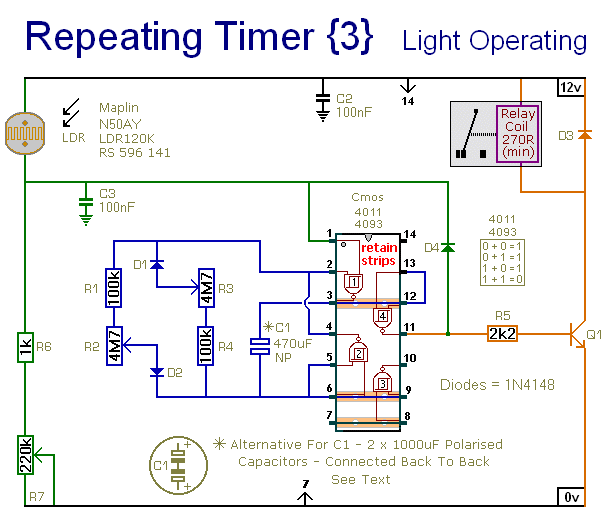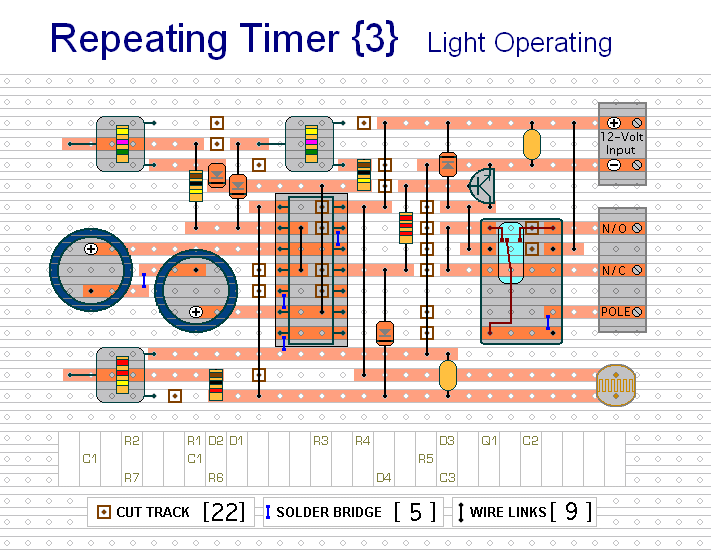This circuit has an adjustable output timer that will re-trigger at regular intervals. It's controlled by a light dependent resistor - and can be set to operate only during daylight hours.
This circuit is very similar to Repeating Timer No.2.
However - the addition of the light dependent resistor means that the operation of this timer can be limited to the daylight hours. R7 lets you set the level of light at which the timer will stop. The type of LDR is not critical. The important thing is the voltage on pin 1. Any type of LDR should work satisfactorily. But you may need to change the value of R7 - to achieve the desired range of adjustment.
Schematic Diagram
Click Here For A Photograph Of The Prototype

Setting The Timer
The circuit is basically an Astable Oscillator. And the output times depend on the value of C1 - and the speed at which it charges and discharges through the resistor network. The length of time the relay remains energized is controlled by R1 & R2. And the length of the time it remains de-energized is controlled by R3 & R4. The fixed resistors set the minimum period lengths - and the maximum period lengths are set by R2 & R3. With the component values shown - both periods are adjustable from about 1 to 30 minutes.
You can change the component values to suit your own requirements. If your time periods don't need to be too precise - and more-or-less is close enough - you can leave out the pots altogether - and simply rely on R1 & R4 to set the times. Owing to manufacturing tolerances - the precise length of the time periods available depends on the characteristics of the actual components you've used - and a 4093 will produce longer time periods than a 4011.
 Do not use the "on-board" relay to switch mains voltage. The board's layout does not offer sufficient isolation between the relay contacts and the low-voltage components. If you want to switch mains voltage - mount a suitably rated relay somewhere safe - Away From The Board. I've used a SPCO/SPDT relay - but you can use a multi-pole relay if it suits your application.
Do not use the "on-board" relay to switch mains voltage. The board's layout does not offer sufficient isolation between the relay contacts and the low-voltage components. If you want to switch mains voltage - mount a suitably rated relay somewhere safe - Away From The Board. I've used a SPCO/SPDT relay - but you can use a multi-pole relay if it suits your application.
Alternative Capacitor
When the oscillator is running - the polarity of the charge on C1 keeps reversing. So C1 needs to be non-polarised. However - you can simulate a non-polarised 470uF capacitor by connecting two 1000uF polarised capacitors back to back - as shown. How and why this works is explained in the Detailed Circuit Description. Because non-polarised capacitors aren't widely available - the prototype was built using two polarised capacitors.
Veroboard Layout
Click Here For A Photograph Of The Prototype

The timer is designed for a 12-volt power supply. However - it will work at anything from 5 to 15-volts. All you need do is select a relay with a coil voltage that suits your supply. The Support Material for this circuit includes a parts list - a step-by-step guide to the construction of the circuit-board - a detailed circuit description - and more.
 SUGGESTIONS
SUGGESTIONS
 SUGGESTIONS
SUGGESTIONS


